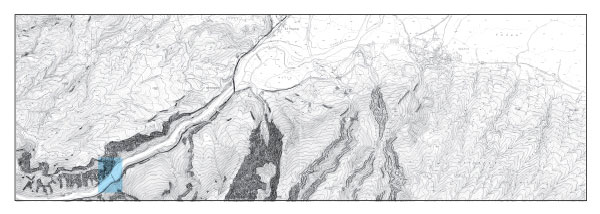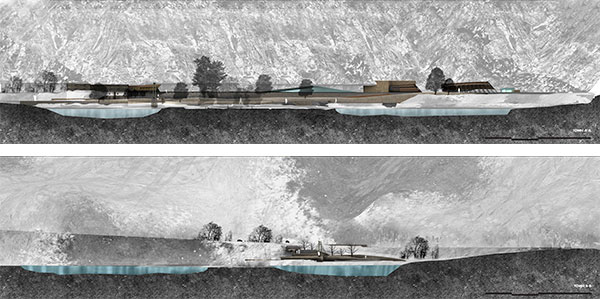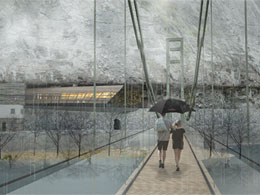STUDENTS PROJECTS
PROJECTS2013
Students: Aikaterini Mpakaliou, Eirini - Dafni Sapka
Supervisor: Anastasios Tellios
Aristotle University of Thessaloniki, AUTh.
Presentation Date: October 2014
The proposal of this thesis focuses on the area of Aghia (Saint) Paraskevi, which is a key staging point for the Tempe Pass. It aims to highlight the unique identity of the place, to connect the basic functions, and to incorporate the sculptural design with the natural landscape, linking the past, present and future.

The Vale of Tempe (Greek: Tέμπη, Témpi) is located, in Greece, between Olympus to the north and Ossa to the south. Through the Vale the Pineios River flows on its way to the Aegean Sea. The strategic importance has already been noticed by Herodotus, as it is the only passage to the coast between the mountains of Thessaly, which due to the narrowness of the valley could be easily controlled. Tempi have also excellent geophysical interest and that is why have been a place of worship and inspiration for the Greek mythology.
The name Dotia Tempea or Dotiou Pylai relates to both Dotia daughter of Elatos, ruler of Lapiths residing in Larissa in Thessaly, from which the valley was named "Dotion pedion" (Dotion field), and with the verb "intersect", as a result of the corrosion that the water caused by flooding the plain of Thessaly, according to Apollodorus. According to Hesychius it refers to the "mountains narrows" between Olympus and Ossa.
In ancient times, as in modern times, the main road between Thessaly and Macedonia was passing from the right side of the Valley, at the foot of Ossa. Today the new highway is constructed underground, on the same side, while on the left has already constructed a new underground railway tunnel. The two earlier railway lines that cross the area are not used anymore.
The approach of the intervention area by the side of the road in the direction of Thessaloniki is done through an underground passage, while a suspension bridge connects the two banks of the Pineios. However, the dysfunctional access, the lack of maintenance of existing infrastructure and the overflow of the river, generate fragmented areas and shows a permanent abandonment scenario.
The design approach of the proposal, is based on vortex and dynamics of flows that inundate the area, either they are more linear and strict (such as highway, railway lines, the pedestrian bridge) or are more natural and free (springs, river, wind).
Depending on the season and the weather conditions the flow of Pineios, the quantity and the momentum of the water varies.

In order to respond functionally to this variability, the space is scaled by levels that are consolidated with ramps, to ensure free access to all the visitors. By this design is achieved a safe access to the area, even if the overflow of the river reaches the maximum limit.



As a tool for space organization, unification and protection from the momentum of the water artificial slopes are proposed. They have organic form to incorporate natural landscape and also to form a unified, dynamic and fluid space. As the natural level of water rises, the designed landscape is changing, and the limits of the bank are continuously redefined. Overall, a continuously evolving process as a "river" is designed, merging the meaning of tension with the meaning of change.
Three natural springs on the north bank, from the caves of Olympus, feed the waters of Pineios. The space around the springs is an amphitheater, showing respect to the native vegetation, and making a design reference to the geological phenomenon of erosion.
According to mythology, the worship character of the place is directly linked to water springs and Pineios. The Vale of Tempe was dedicated to the worship of Apollo, god of purification and divination. In a very close distance from the main source were found traces of the sacred of Apollo the Pythian or Tempeiti, confirmed by inscriptions. There, every eight years, took part the Septiria, rituals involving the purification of child from Delphi and the sacred plant of Daphne, who was transported back in procession (dafnoforia).
The amphitheater design approach and the positioning of a floating construction for hosting outdoor cultural activities at the central point of the source, aimed to connect the design with the memories of the place.
Abandoned old railroad infrastructure is maintained and reused. The tunnel of the first line intended to be a museum, while the second line of Tempe is reused as a museum railroad with execution excursion routes. A new passenger station is designed with a small scale for the Ag. Paraskevi station, while new infrastructures are designed with the concept of the speed of trains. A small hosting station with conference room is also incorporated in the mountain.
We propose materials such as local stone, gravel, wood and compacted earth.
The unique natural beauty of Olympus and Tempe, the scattered archaeological sites, monuments and diffuse historical memories reveal the uniqueness of the place. In our proposal we want to enhance and highlight this character to create a new cultural core and new memory scapes for visitors.















